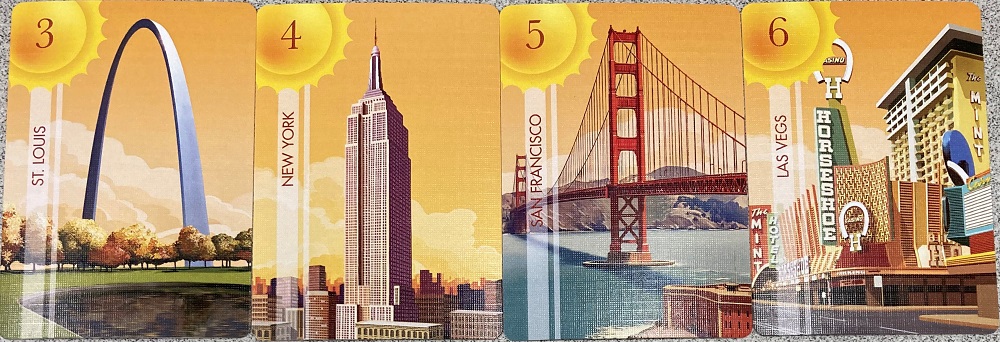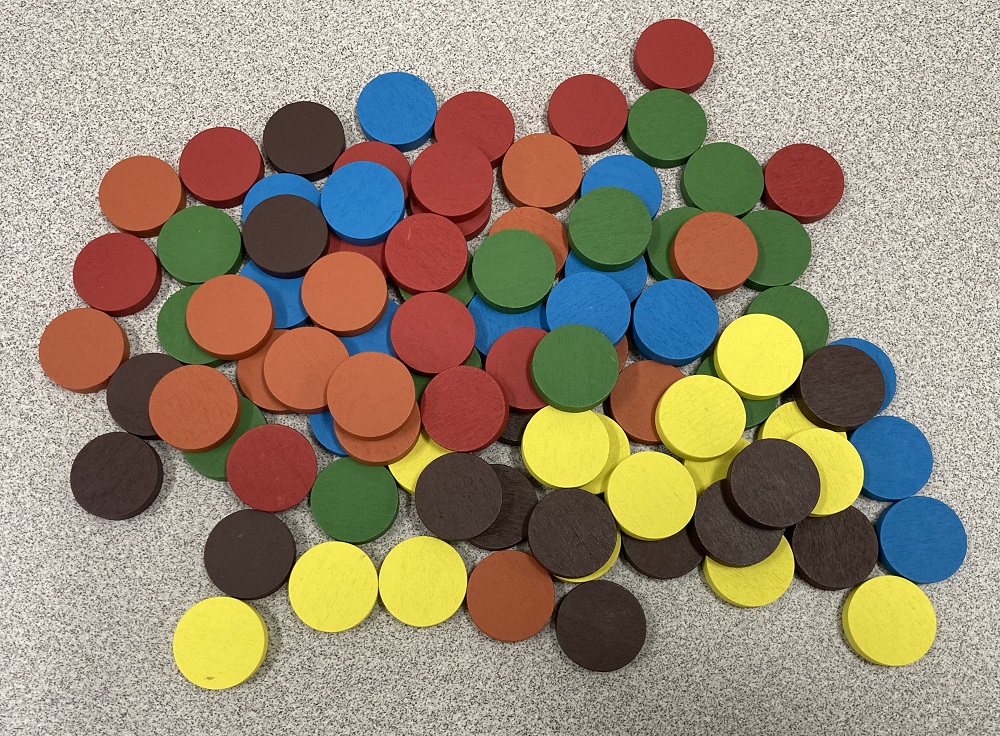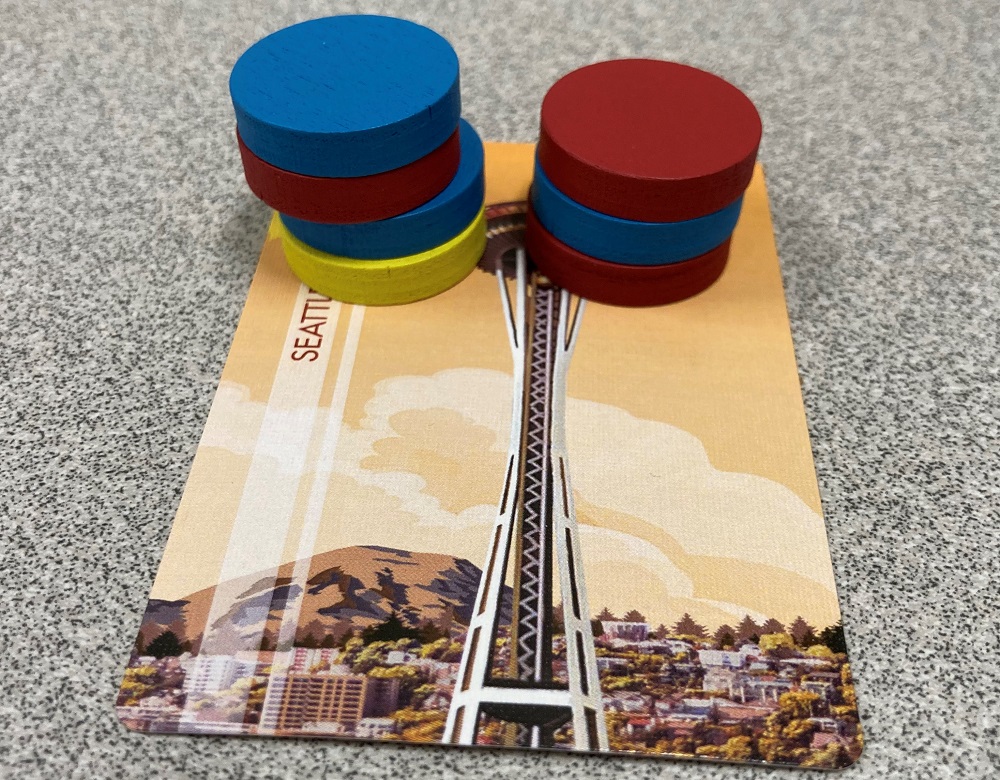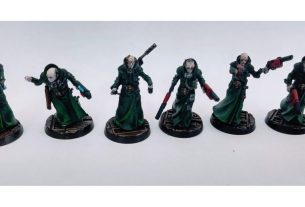You are the owner of soda pop company in the 1960s and want to expand your brand across the country to become the country’s most popular soda. In order to improve your reputation, you have marketing and advertising resources at your disposal as you target specific cities. Play your cards and bottle caps correctly and you may just become the Top Pop.
What Is Top Pop?
Top Pop is a collecting game for 2-5 players, ages 8 and up, and takes about 60 minutes to play. It’s currently seeking funding on Kickstarter, with a pledge level of $25 for a copy of the game. Top Pop was designed by Mark McGhee and Joshua J. Mills, published by Talon Strike Studios, with illustrations by James Churchill.
New to Kickstarter? Check out our crowdfunding primer.
Top Pop Components
Note: My review is based on a prototype copy, so it is subject to change and may not reflect final component quality.
Here is what you get inside the box:
- 1 Rule Book
- 35 City Cards (Day)
- 7 City Cards (Night)
- 1 Score Pad
- 6 Player Boards
- 75 Stackable Caps
- 7 City Power cards (Kickstarter exclusive)
- 12 Scenario cards (Kickstarter exclusive)

The six player boards each contain unique art representing the six soda companies in the game. Not only do they show each player’s company, they also serve as a quick reference for game rules including setup, turn phases, and specifics on how to collect caps, how to play caps, how to collect cities, and the end game scoring.

The city cards represent the seven different cities in the game. Each city has a number in the top left corner representing how many cards of that city are included. For example, there are 3 St. Louis cards and 9 New Orleans cards with numbers in-between those two. A night card for each city is included in that count. The 7 city power cards which are used for scenarios of the game will be a Kickstarter exclusive. When a player wins a city card, they also get the matching city power card and can use its ability until another player wins a card of that city, then they get to use it.

The score pad is used to calculate the total scores for each player at the end of the game.

The final version of the game will feature plastic tokens that look like bottle caps with the color and logo for the six different soda companies. The prototype I used for my review contained wooden discs to represent the caps.
How to Play Top Pop
You can download a copy of the rulebook here.
The Goal
The goal of the game is to score the most points with a combination of city cards that you collect by the end of the game.
Setup
Start off by creating a constructed deck of city cards depending on the number of players. There should always be two more cities than there are players. For a two-player game, use the 18 cards with St. Louis, New York, San Francisco, and Las Vegas. Add Chicago for three-player games, Seattle for four-player games, and finally New Orleans so you have all 7 cities for a five-player game. Shuffle this deck and place it face down in the middle of the table. Next give each player a Soda Company board of their color. Put all 15 Bottle Caps of each player’s color in the middle of the table. Caps of colors that players are not using are returned to the game box.
Determine which player will go first. Now give players their starting resources which depend on turn order. The first player gets 1 cap of their color and a hand of 3 cards. Second player gets 2 caps of their color and a hand of 3 cards. Third player gets 1 cap of their color, a hand of 4 cards, and then can select 1 of their cards to place down in front of them. Fourth player gets 3 caps of their color and a hand of 3 cards. Fifth player gets 2 caps of their color, a hand of 4 cards, and can place 1 of their cards in front of them. You are now ready to play.

Gameplay
Players take turns in order. Each turn consists of five steps which must be completed in order.
Win City Cards
This step is skipped on a player’s first turn. On subsequent turns, the active player looks at the city cards which are in front of all players. If the active player has the tallest stack of caps on any of these city cards, they then take those cards and put them face down in their score area. These caps must have been placed on a previous turn. For each card won, the caps in the tallest stack are given to the player that the card is in front of unless the active player wins the card if front of them. Then the stack of caps goes into the middle. (You can’t collect caps during this phase if you are the active player.) Everyone else that has a stack of caps on the won city cards get their stacks of caps back. If you win your 6th city card, then you trigger the final round of the game.

Place a City Card
The active player must choose one of the city cards in their hand and either place it in front of another player or in front of themselves. If you place a card in front of another player, you can take a cap of their color from the middle. You do not do this if you place the card in front of yourself. If you place a night card, with the moon on the back, place it face down. You can look at it and the player you place it in front of may look at it, but no one else unless they win it. Remember, if you place a card in front of yourself and another player eventually wins it, you get the tallest stack on the card.

Collect Caps
Pick up one cap from the center. You can choose any color. Be sure to consider which colors you will need to create a stack to place during the next phase.
Place Stacks
This is where you commit marketing resources to build up your reputation in cities. Use the bottle caps in your supply to create stacks to place on city cards. You can only have one of your stacks on each card. When placing a stack, you must follow some rules. Your stack must always have a cap of your color on top. When you place a stack, it must be the tallest stack on the card. If it is still the tallest stack when it is your next turn, you win that card. If other players have a stack already on a card, identify who owns the tallest stack. If you are placing a stack, you must also have a cap in the color of the owner of the tallest stack in your own stack. All other caps can be in any color. If you already have a stack on the card, but it is not the tallest, you can add to your stack. You just have to have a cap of your color on top and a cap of the color of the tallest stack. Leave all other stacks on the card. If you don’t have caps in the correct colors, you can’t place a stack.

Draw a Card
Finally, draw the top card from the deck and place it into your hand. If the deck is empty, skip this step.
Game End
When a player wins their 6th city card, this triggers the end of the game. This will be their final turn. Then each other player gets one more turn before the game ends. The only difference is that during a player’s final turn, they do not place a city card from their hand. Any cards remaining in players’ hands can just be returned to the top of the deck since they will not be used for the remainder of the game. After the last player’s turn, city cards still in front of players are won by whoever has the tallest stack on them. City cards with no stacks are discarded and no one wins them.
The cards each player has won during the game are used to determine the winner. A scoring sheet from the included pad is used to tally up each player’s points. If a player has more of one type of city card than any other player, they score 2 points per card they have of that city. If there is a tie for that city, then each player in the tie gets 1 point per card of that city. All other players get nothing. Next you can earn points for diversity. This is determined by the number of different cities you have in your pile. There are no points for just one city. Two different cities score you 2 points, three different cities earn 4 points, four cities get 6 points, five cities award 8 points, six cities net you 10 points, and if you can get seven cities, the bonus is 12 points. Tally up all of the points and the player with the most points wins. If there is a tie, the player with the most cap tokens is the winner.
Why You Should Play Top Pop
One of the main features that caught my eye when I first heard about Top Pop was the unique cap tokens which look like bottle caps from soda bottles. While the prototype I received did not have these tokens, the ones that will come with the final game look very cool. The rules are fairly simple and easy to learn. The only difficult part is the stacking requirements to win a city. The key is to remember to have one of your color of tokens as well as one of the same color as the top of the current high stack. Once players have this down, they can then concentrate on strategy. I am impressed that there is more thinking and planning involved than one would expect just by reading the rules. Since each player places a city card down each turn, after a few turns there are quite a few cities up for the taking. Cap tokens also become a very important resource. Sometimes you may want to let other players win a city card in front of you just so you can claim the tokens. After playing one game you want to play again to try something different.
I am very impressed with Top Pop. My family had a lot of fun playing this game. The first game takes a bit of learning. However, once everyone understands the rules and how to play, it goes fairly quickly. I like the thinking and decision making which keep players engaged in the game. Do you try to win a city you need or use your tokens to block another player from getting their goal? I recommend Top Pop with its nostalgic table presence and easy-to-learn but challenging to master gameplay for families as well as gaming groups. I can’t wait to get my hands on the final product. Until then, I will drink a pop while I wait.
For more information or to make a pledge, visit the Top Pop Kickstarter page!
Click here to see all our tabletop game reviews.
![]() To subscribe to GeekDad’s tabletop gaming coverage, please copy this link and add it to your RSS reader.
To subscribe to GeekDad’s tabletop gaming coverage, please copy this link and add it to your RSS reader.
Disclosure: GeekDad received a prototype copy of this game for review purposes.





